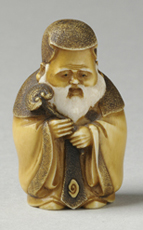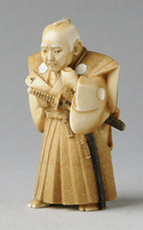Ichiro: A Life's Work of Netsuke, The Huey Shelton Collection
Sept. 5 - Dec. 23, 2009


Now available: Ichiro: Netsuke, A Life's Work Cell Phone Audio Tour
Inada Ichiro (Japanese, 1891-1979) was an important 20th century netsuke artist. For centuries, the Japanese have used miniature sculptures hung by cords from the sash of their traditional garments such as the kimono to secure personal belongings in small pouches. Intricate and figurative, the netsuke reflect aspects of Japanese life.
In the genre of twentieth-century netsuke carving, Ichiro Inada (Japanese, 1891-1977) is regarded for his enchanting designs drawn from genre and Kabuki theater subjects, and as the artist who first used paint extensively on ivory. Threaded through his long career as a netsuke carver has always been his love of painting. At the age of twenty-five, after studying ivory carving for twelve years with the master Sano Koichi, he was expelled for expressing the desire to study Western painting. Ichiro went on to study painting, financing his education at the Nippon Bijutsuin by carving netsuke. At the age of thirty, he finished his schooling and set himself up as an ivory artist, focusing on netsuke, okimono (cabinet size pieces), and Buddhist statues. During World War II, when ivory was virtually unobtainable, Ichiro carved netsuke from wood. Some netsuke collectors consider his wood netsuke of this period his finest works. After the war, when he resumed ivory carving, he concentrated mostly on figures from Kabuki plays, Japanese history, and everyday life. It was then that he felt his "little people" would be more real if he could improve methods of coloring ivory. He used pure pigments, and his blues have become an Ichiro hallmark. He used only hand tools, saws, and drills. Ichiro preferred a dull finish, but what little polishing was necessary he did himself with the leaf of the muku tree or very fine sandpaper. His netsuke are original and skillful, but not pretentiously intricate in technique. They are carved from a rough pencil sketch, true to tradition in subject matter, strong, and somewhat stylized in design.
The mode of dress in feudal Japan for both men and women was a long robe-like garment of wrap-around style called a kimono. It was kept closed in front by means of an obi (waist sash). There were no pockets in the kimono. The men wore tobacco pouches, moneybags, writing implements, and inro (compartmented cases for medicines or seals) suspended by cords from the obi. To prevent the sagemono (suspended object) from slipping, a small toggle was attached to the other end of the cord. This toggle was a netsuke (meaning "root attachment"). Toggles have been used by other cultures throughout the world, but only the netsuke evolved into an art form.
The majority of netsuke were carved of wood or ivory. Other materials included lacquer, stag antler, horn, boar's tusk, coral, amber, and pottery. Some artists combined materials and used inlays effectively. To fulfill their function as toggles, netsuke had to be reasonably lightweight. They had to be small enough to rest or dangle at the top of the obi and not interfere with freedom of movement. They had to be rounded and free from sharp projections that could tear the fabric of a kimono or jab the wearer.
The most common form in netsuke is katabori, three-dimensional carvings. The second most common form is manju, named after the round rice-cake it resembles. Its button-like shape is usually decorated with a carving in high or low relief.
Netsuke had to have himotoshi (holes) for the cords which pass through the inro, through the ojime (a bead which slides down the cords to keep the inro cases together), into the netsuke and then knotted so the entire ensemble could hang from the obi. Some artists incorporated openings in the design of a piece, such as the space between the body and the folded legs of a reclining animal, rather than drilling holes in the side worn against the body.
The subjects depicted in netsuke (as well as inro and ojime) are endless and record every phase of Japanese life during the Tokugawa (Edo) Period. Love of nature, especially the lower forms, is evident in netsuke art. Animals, birds, humans engaged in occupations or frivolity, heroes, deities, mythical creatures, legends, toys, and everyday objects are all treated, sometimes seriously, sometimes humorously. Among the most popular subjects are the animals of the zodiac.
Images:
Left: Ichiro Inada (Japanese, 1891-1977), Jurogin Holding a Scepter, not dated, Ivory, 1-1/4 x 3/4 x 7/8 inches, The Huey G. and Phyllis T. Shelton Collection of Ichiro Inada Netsuke, University of Wyoming Art Museum Collection, 2009.5.129
Right: Ichiro Inada (Japanese, 1891-1977), Elderly Samurai Standing Pensively, not dated, Ivory, 1-1/4 x 7/8 x 1 inches, The Huey G. and Phyllis T. Shelton Collection of Ichiro Inada Netsuke, University of Wyoming Art Museum Collection, 2009.5.135
Funded by Edelweiss Funds, Mr. & Mrs. Norris Love, the Claude & Marilyn Boles Foundation in honor of Huey G. Shelton, and Phyllis T. Shelton.


